Dog Talks For Dummies
It's certainly no secret that I love dogs. In the last 20 years, there have been maybe 5 days when I didn't have to care for a dog. And this was only because my sister and I were moving and we took our dogs to a pet boarding facility for 5 days. These days were hectic, and even amid all the hustle and bustle of moving, I missed my dogs. I have learned a lot in those 16 years. My only experience with raising a dog from home was with our Remco. A Kooikerhondje that we had when both my sister and I were children. And no matter how much we all loved Remco, this could not have prevented this experience from being positive. After several serious biting incidents, my parents had to make the difficult decision that Remco would be rehomed. Fortunately, this turned out well, and even though I was the one who suffered the most damage from Remco, I was also the one who missed him the most. When my sister bought Micky, she brought him every day to my parent's house, (where I still lived at that time), so that he wouldn't be alone during the day while my sister was at work. In hindsight, none of us knew what we were getting into.
Fortunately, Micky was a very easy-going dog, there was no harm in him. He wasn't rude, he wasn't annoying, he was just an adorable dog with a super social character. And more importantly, he wasn't big and therefore not that strong. And...he was my sister's dog. My sister took several obedience courses with Micky. We thought we were doing very well, but we were lucky that Micky was the kind of dog who forgave all your mistakes and did not develop any problems because of our mistakes through ignorance. We thought we were treating Micky lovingly, and we did, with the knowledge we had at the time. But we didn't know what it means to have loving communication with your dog!
And loving communication with your dog is so crucial for your dog and for you to build a good, healthy, and, above all, happy relationship with each other. Many people still think you should raise a dog with the idea of "I am the boss of the house and the dog just has to listen". As a result of this way of thinking, people teach their dogs all kinds of commands. Still, many people also will often correct or outright punish the dog if it shows behavior that they consider undesirable. What they do with this is suppress the dog's natural behavior. And this is not a good basis for building a good relationship with a dog. I have to admit, I have made almost all the mistakes that I could make in the 20 years that I have had dogs. No, I never hit or kicked a dog, but every other mistake I could make, I made! Luckily my dogs were willing to forgive me for my ignorance. Together we have learned through trial and error, and each dog has given me new insights, and I still learn something new every day.
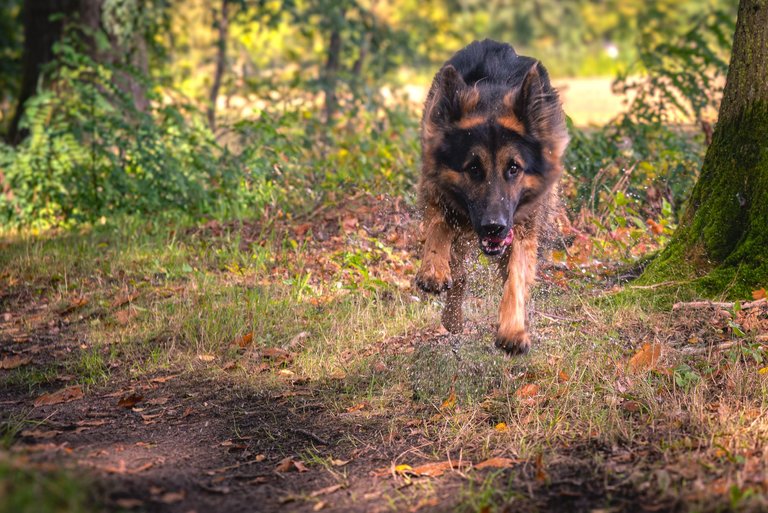
The Dominance Theory: An Outdated Concept
Let's start with why we should forget about domination theory! The dominance theory is based on outdated research conducted on wolves in captivity. And as we all know, wolf captivity is a completely unnatural way of life. These wolves are placed together and are certainly not a natural pack. A natural pack consists of a father, a mother, and their pups. Often from different litters. In these types of packs, there is natural behavior. In a human-composed group of wolves in captivity, this natural behavior is not present because the situation in which the wolves live is already not natural. They are not a pack either. These outdated studies suggested that within a group there is always an alpha animal that enforces its position through aggression. Because a dog is descended from a wolf, many trainers all over the world have run with this theory. This theory was applied to dogs worldwide. This led to the development of observation techniques, behavioral assessments, and training techniques that all assumed the presence of an "Alpha Animal". And of course, humans had to fulfill this Alpha role. As a result, this research with incorrect results has led to methods that are only based on suppressing the dog to maintain the 'dominant' position of the owner.
However, later research has shown that dominance theory does not apply to dogs. Dogs evolved from wolves, but their social structures differ significantly. The similarity is that it is unnatural for dogs to live in our homes. In many countries, there are still many dogs living in the wild. And new studies of these 'wild' dogs have shown that they don't have a set hierarchy at all like captive wolves did. These dogs, who live according to the natural way, live in groups with flexible structures based on cooperation and mutual support. These new findings indicate that dogs are not motivated by the need to show dominance, but rather by social interactions and the avoidance of conflict.
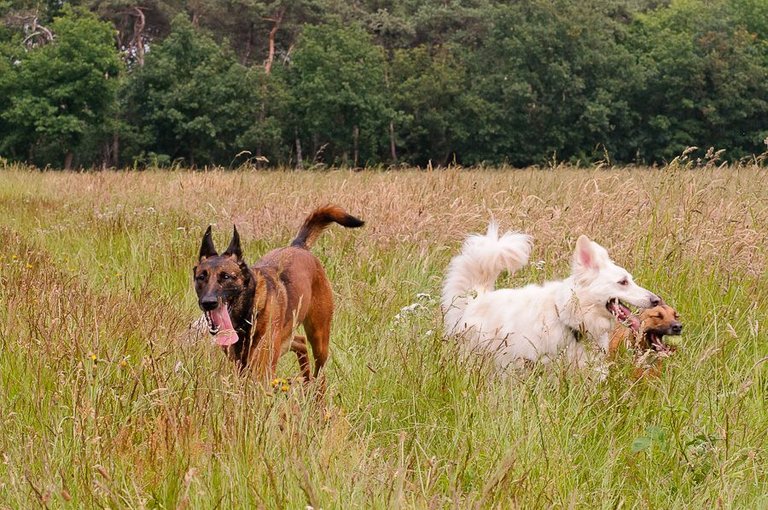
Dogs are Conflict Avoidant
It is important, for example, that dogs are by nature very social and conflict-avoidant. Dogs don't want conflict at all, not with each other, but also not with people. They exhibit a wide range of signals to reduce tension and promote harmony. By understanding and responding to this subtle body language, we can improve our communication with dogs. But there is a big problem there, because how much do we humans understand about dog language?
Some Examples of Dog Language:
Let's look at some common calming signals that your dog uses to indicate that he or she does not like something and wants to avoid a conflict.
Calming Signals: Dogs use signals such as looking away, licking their lips, yawning, and shaking themselves to reduce tension.
Posture and Movement: A relaxed dog will have a loose, waggling tail, while a stressed dog may exhibit stiff movements and a tight tail. A dog's ears also tell a lot. If they stand alertly forward, the dog feels a tension or excitement that he finds fun or threatening depending on the situation. If he has pulled his ears far back, your dog is stressed or he likes something. And here lies the difficulty, as you can already notice, it is not a thing that allows you to see what your dog means. You will have to pay attention to the situation, but also to the rest of the body language. Eyes also tell a lot, a dog with half-closed eyes, leaning against a leg and the ears lying flat back on the head is enjoying himself. With a dog with wide open eyes, and ears flattened back is a completely different story. This dog does not feel comfortable, is very stressed, and does not like it.
Vocalizations: Then we have the whole range of sounds that dogs can make. They bark, they can growl and they can howl. These are all ways that dogs express their emotions. It is important to learn what different vocalizations mean in different contexts. Here too you must learn to listen to the differences to know what they mean. One bark is not the same, no, not even if we are talking about the same dog. For example, I know when Skipper barks because there is a postman, or when he barks because he wants to play, or when he barks because he doesn't trust a situation. In all three cases, it is the same dog, and in all three cases, it barks. But the tone of his bark tells me what's going on, and also how to respond.
By paying attention to these signals we can better respond to the needs and feelings of our dogs, which should lead to a better relationship with your dog.
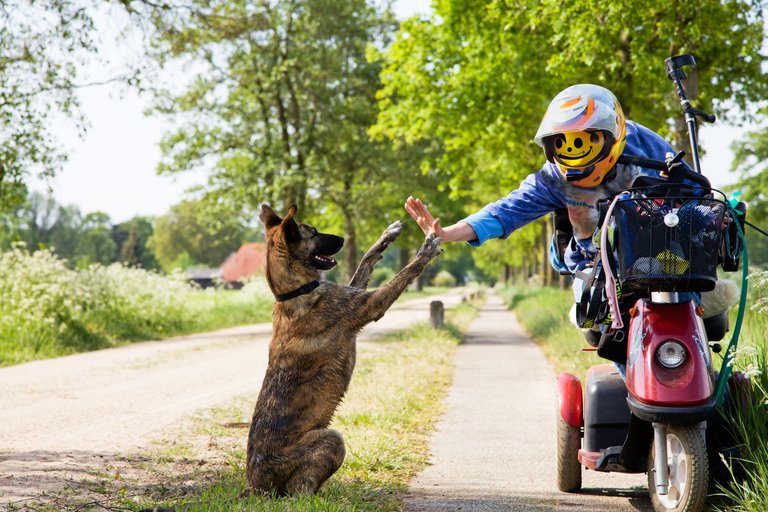
Communication as Two-Way Traffic
The old dominance theory has told us for years that a dog has to listen. This often meant that there was very little to no communication with the dog. We told the dog, in our language, what we wanted from him and he just had to listen. Does this work? Depending on what kind of relationship you want to have with your dog, it can be said that it can work. A dog is so social and conflict-avoidant by nature that he will do everything to avoid that conflict with you. And a dog is so good at observing and learning that he will learn to do what you want, anything to make you happy. That's where the famous "will to please" comes into play. But does this make your dog happy? That's a completely different question you ask yourself. And then the answer is, "No, not necessarily."
A dog certainly needs boundaries and guidance. But you don't have to become a drill sergeant for that. Effective communication with your dog is a two-way street. We do that as humans among ourselves, and a dog needs this too. After all, they all have their personality and character, and a dog is much more sensitive than a human. For us, that means a shift in thinking, realizing that we not only have expectations of our dogs but also listen to what they are trying to tell us. Now you may be wondering how you do that. Here are some tips to promote healthy communication:
1. Observe and Listen
Take the time to observe your dog and listen to their signals. This will help you better understand what they need and how they are feeling. Watch for subtle changes in their body language and behavior.
2. Positive Reinforcement
Use positive reinforcement to reward desired behavior rather than punish unwanted behavior. Reward your dog with treats, praise, and games when they exhibit good behavior. This encourages them to repeat this behavior.
3. Patience and Understanding
Be patient and understanding. Dogs learn at their own pace and may sometimes need time to understand new commands or behaviors. Don't punish them when they make mistakes, but help them get it right. Offer your dog the opportunity to learn from his mistakes and grow by rewarding the behavior you want to see.
4. Respect for Individual Characters
Each dog has its own character and unique needs. Some dogs are more outgoing and energetic, while others are calmer and more reserved. By respecting and appreciating these individual differences, you can build a deeper bond with your dog.
Differences in Communication between People and Dogs
Understanding the differences between human and dog language is crucial for effective communication. While we humans often rely on words and hand gestures, dogs mainly use body language and scent.
1. Posture and Movement
- Humans: Humans walk upright on their hind legs and use their hands to explore and manipulate the world. Our body language is often supported by facial expressions and hand gestures. From a dog's perspective, we appear very threatening because in the dog world, a top-down approach is experienced as very threatening.
- Dogs: Dogs walk on four legs and use their mouth, paws and entire body to communicate. They rely on subtle changes in posture and movement to convey their feelings and intentions.
2. Sensory Perception
- Humans: We rely heavily on our eyes and hands to gather information. Our hands act as important tools for grasping and examining objects.
- Dogs: Dogs use their nose as their primary sense. They explore the world primarily by smell, which means scent marks and scents play an important role in their communication. In addition, a dog will investigate everything it can with its mouth.
3. Vocalizations
- Humans: We use a wide range of words and phrases to communicate. Our language is complex and can convey nuances and emotions.
- Dogs: Dogs use vocalizations such as barking, growling, whining, and howling to express their emotions and intentions. The context and tone of these sounds are crucial to understanding what a dog is trying to communicate.
4. Facial Expressions
- Humans: Our faces are very expressive and can show a wide range of emotions, from joy to sadness to anger.
- Dogs: Although dogs also have facial expressions, these are more subtle and less diverse than those of humans. Dogs rely more on body language and posture to communicate their feelings.
5. Touch and Physical Contact
- People: We attach great importance to physical contact such as hugs and handshakes as forms of social bonding and comfort.
- Dogs: Dogs use physical contact in different ways. A gentle nudge with the nose, leaning against you, or licking are all forms of affection and communication.
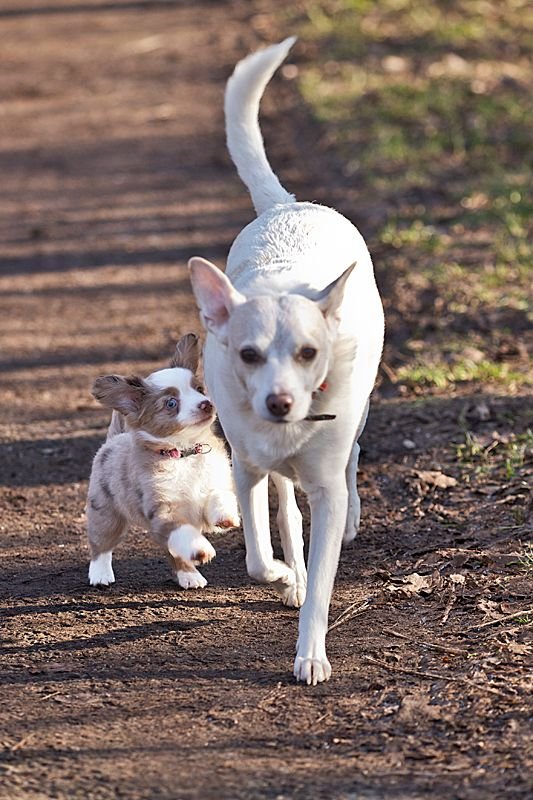
Moving into the Dog's Perspective
To communicate effectively and lovingly with your dog, it is important to put yourself in their perspective. Here are some ways to do this:
1. Understand Their Senses
Dogs see the world differently than we do. Their sense of smell is thousands of times stronger than ours. Try to understand how important scents are to them and how they use them to navigate their environment and communicate.
2. Observe Their Body Language
Pay attention to the subtle signals your dog gives. Pay attention to changes in posture, movements and facial expressions. By learning to recognize these signals, you can better respond to their needs and emotions.
3. Respect Their Ways of Communication
Respect the ways dogs communicate, even if they differ from how we do. Understand that a dog who sniffs the ground or leans against you is talking to you in his way.
4. Adjust Your Own Behavior
Adjust your behavior to communicate better with your dog. Use a calm, gentle voice and avoid sudden movements that could frighten your dog. Create an environment where your dog feels safe and understood.
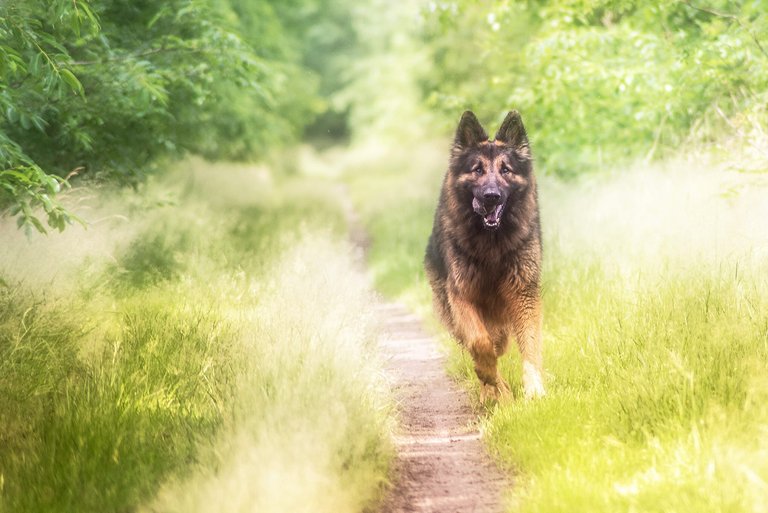
Conclusion
Communicating lovingly with your dog without corrections or punishment is the key to a strong, healthy, and happy relationship. By leaving dominance theory behind and focusing on understanding dog language and respecting our dogs' unique personalities, we can build a much better bond and solve and prevent many behavioral problems. And ultimately have a much happier dog around us.
Posted Using InLeo Alpha


Fantastic work! Have you had a chance to read Do No Harm Dog Training by Linda Michaels? I have a feeling you already have but if not, you should definitely check it out as it will reinforce the teachings you have shared here as well.
Thank you! Yes, I've read that and it's absolutely fantastic and so very true. I'm also a fan of Turid Rugaas and the calming signals she teaches about. It's so very helpful to understand the dog language.
I love how you've emphasized understanding and respect in building a relationship with dogs. It's so true that effective communication is a two-way street, and it really makes a difference in their happiness and behavior. Very very great work friend
It does make a big difference, yet so many people don't try to understand their dogs at all. They just teach their dogs commands they think their dog should know, but do nothing to understand how their dogs communicate with them. For example, most people who see a dog with his ears pulled back, and his tail between his legs, loudly barking, will say that's an angry dog. They don't understand that this dog is not angry but scared. They only hear the barking and don't look at his body language. So they probably punish the dog for the barking and tell him to shut up. Result, the dog does not find support and barks even more loudly the next time because there is something that scares him, something he doesn't trust. Because he has learned that loudly barking makes the thing he's scared of go away.
This is how dogs learn unwanted behavior. And the irony is that the dog is blamed for doing so, while in reality, we are the ones to blame.
Wow I infact just learned that it doesn't mean they're angry but actually scared 😳😳😳😳 didn't know that
View more
🤩🤩🤩
Dogs and animals in general become more and more likely the best and most trustworthy friend a human being can have next to him/herself. It's such a loss when we don't invest time into understanding them and sharing time with them. They literally live their whole life with us, and we often forget that their lives are rather short! :(
!WEED
So very true!
great article and I agree the dominance method is incorrect and should never be used. Dog's understand and learn and react by their up bringing. great article we can tell you love your fur babies.
It's not just their upbringing, it's mainly because people refuse to understand how the dogs communicate with us. And understanding their communication precisely is the key to their happiness. Now we don't have to bark like they do, but dogs communicate with so much more, and it's the subtle signals that we, humans, miss. Recognizing and understanding subtle communication is the secret to a good bond with your dog, and to preventing and solving many problems. Problem behavior that a dog has developed is often because most people do not understand their dog and therefore react incorrectly. An anxious dog can bark loudly at something, just like a dog that is angry at something can also bark loudly at it. But in both cases, the human will have to understand what is going on and why the dog is barking so loudly. To do this, you must understand what the dog communicates with its posture. These are small signals, but they are there. A dog that is anxious needs support, while an angry dog needs to be calmed down. By the way, most dogs don't get angry that easily. 99 times out of 100 there is something else going on. But this was just to give an example.
My dog's live inside and are treated like people. Our Golden Retriever is loved by all and is a much loved family member. She has loved our kids!
View more
This was outstanding. Thank you for all the information. We have a new dog and she is now almost two years old and her and I have bonded so much that she and I feel each others thoughts. It is amazing. She tend to nudge my legs to let me know when she wants something. ❤️
Wishing you many more happy years to come. Enjoy each other! ❤️
Thank you very much, that was sweet of you!
This is fantastic advice. What a great article.
Thank you!
Our Rep is low due to wrongful Downvotes
STOP THE DOWNVOTE ABUSE ON HIVE
https://hiveblocks.com/@spaminator
https://hiveblocks.com/@adm
https://hiveblocks.com/@steemcleaners
https://hiveblocks.com/@davidthompson57
https://hiveblocks.com/@crimsonclad
https://hiveblocks.com/@guiltyparties
https://hiveblocks.com/@oflyhigh
https://hiveblocks.com/@abit
https://hiveblocks.com/@nuttin
https://hiveblocks.com/@cwow2
#stopthedownvoteabuse on #HIVE
No DOWNVOTES ON BLURT
Credit: atheistrepublic
Earn Crypto for your Memes @ HiveMe.me!
@tipu curate
Upvoted 👌 (Mana: 10/60) Liquid rewards.